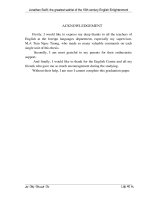math in 18th century
Bạn đang xem bản rút gọn của tài liệu. Xem và tải ngay bản đầy đủ của tài liệu tại đây (1.45 MB, 50 trang )
In 18th century mathematics is
already a modern science
Mathematics begins to develop very
fast because of introducing it to
schools
Therefore everyone have a chance to
learn the basic learnings of
mathematics
Thanks to that, large number of new
mathematicians appear on stage
There are many new ideas, solutions
to old mathematical
problems,researches which lead to
creating new fields of mathematics.
Old fields of mathematics are also
expanding.
FAMOUS
MATHEMATICIANS
LEONHARD EULER
Leonhard Paul Euler
(1707-1783)
He was a Swiss mathematician
Johann Bernoulli made the biggest
influence on Leonhard
1727 he went to St Petersburg where
he worked in the mathematics
department and became in 1731 the
head of this department
1741 went in Berlin and worked in
Berlin Academy for 25 years and after
that he returned in St Ptersburg
where he spent the rest of his life.
Euler worked in almost all areas of
mathematics: geometry, calculus,
trigonometry, algebra,applied mathematics,
graph theory and number theory, as well as ,
lunar theory, optics and other areas of
physics.
He introduced several notational conventions
in mathematics
Concept of a function as we use today was
introduced by him;he was the first
mathematician to write f(x) to denote function
He also introduced the modern notation for
the trigonometric functions, the letter e for the
base of the natural logarithm (now also known
as Euler’s number), the Greek letter Σ for
summations and the letter i to denote the
imaginary unit
He wrote 45 books an over 700
theses.
His main book is Introduction in
Analisyis of the Infinite.
Analysis
He discovered ways to express
various logarithmic functions using
power series, and he successfully
defined logarithms for negative and
complex numbers
He also defined the exponential
function for complex numbers, and
discovered its relation to the
trigonometric functions
EULER’ S FORMULA
For any real number
x,
Euler’s formula
states
that the complex
exponential function
satisfies
Number theory
He contributed significantly to the
theory of perfect numbers, which had
fascinated mathematicians since
Euclid.
His prime number theorem and the
law of quadratic reciprocity are
regarded as fundamental theorems of
number theory.
Geometry
Euler (1765) showed that in
any triangle, the orthocenter,
circumcenter, centroid, and
nine-point center are
collinear.
Because of that the line
which connects the points
above is called Euler line.
Seven bridges of Konigsberg
Seven bridges of Konigsberg
Seven bridges of Konigsberg
Seven bridges of Konigsberg
This was old mathematical problem.
The problem was to decide whether it
is possible to follow a path that
crosses each bridge exactly once and
returns to the starting point.
1736 Euler solved this problem, and
prooved that it is not possible.
This solution is considered to be the
first theorem of graph theory
Euler was very importnat for further
development of mathematics
Next quotation tells enough about his
importance:
“Lisez Euler, lisez Euler, c'est notre
maître à tous ”(Read Euler, read
Euler, he is the master of us all.)
Pierre-Simon Laplace
GABRIEL CRAMER
GABRIEL CRAMER
(1704-1752)
Swiss mathematician
He give the solution of St. Peterburg
paradox
He worked on analysis and
determinants
He is the most famous by his rule
(Cramer’s rule) which gives a solution
of a system of linear equations using
determinants.
THOMAS SIMPSON
THOMAS SIMPSON
(1710-1761)
He received little formal education
and taught himself mathematics while
he was working like a weaver.
Soon he became one of the most
distinguished members of the English
school
Simpson is best remembered for his
work on interpolation and numerical
methods of integration.
He wrote books Algebra, Geometry,
Trigonometry, Fluxions, Laws of
Chance, and others
JEAN LE ROND D’ALAMBERT
JEAN LE ROND D’ALAMBERT
(1717-1783)
He dealt with problems of dinamics
and fluids and especially with problem
of vibrating string which leads to
solving partial diferential equations
During his second part of life, he was
mainly occupied with the great French
encyclopedia









